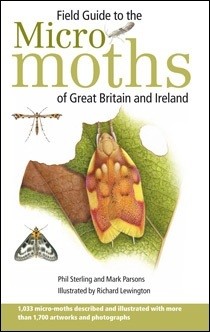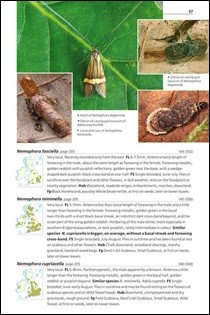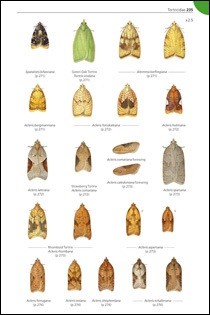Field Guide to the Micro Moths of Great Britain and Ireland

Similar in size to its sister title, this too is very much a field guide: the softback version will fit snugly into a large coat pocket or small field bag, while the hardback alternative will sit nicely on the table at home — where micros can be examined more thoroughly! The 416 pages describe 1,033 species, and are illustrated or described with more than 1,500 items of original artwork and photographs.
A substantial introduction begins with a section on who may find the book useful, and how it should be used to best effect. It continues by describing some basic anatomical features and resting positions of a variety of micro-moth types, including a diagrammatic view of a typical open-winged moth, mapping the various external features. In the next section, this theme is further developed into a full key to the 17 family groups. Biological keys can be extremely hard work, but that depicted here is so well illustrated with visual examples that it encourages the reader to become well acquainted with it. This key is followed by an 'at-a-glance' guide to 45 families, with thumbnails of at least one of the more obvious examples of each. The introduction also includes basic nomenclature and an extensive bibliography, while a very readable section deals with field techniques for finding moths at both the adult and early stages, how to record your data officially, and even a small rogues' gallery illustrating other small insects that may initially look like micro moths! So here, at long last, is a warm and inviting introduction to the broad subject of British microlepidoptera; crucially, it does not leave the reader feeling utterly daunted by overcomplicated (and archaic) language in the first few pages!
The main body of the book is taken up with descriptions of the families. Within these, chosen species are covered in taxonomic order in both a standard and concise way. Each species is headed by the scientific name, appropriate British checklist number and European checklist number. Over 900 species are dealt with, each with a small but well-defined distribution map that portrays the vice-counties in which that species has been recorded. In order, the abundance, forewing length, description, similar species, flight season, habitat and foodplant of each species are then covered. These accounts are accompanied by numerous colour photographs showing some adult, larval and pupal stages, as well as feeding signs on respective foodplants, including many leaf mines and larval cases in situ. The range and quality of these images is excellent, and collectively they probably constitute the largest selection of photos on this subject to have appeared in a single publication. An example from the text can be found to the left; click for a larger view. The 58 plates cover 45 families, illustrating 927 species, and thus represent nearly 57% of the total 1,627 species of British and Irish micros. Richard Lewington has already proven himself as a master artist with earlier works covering butterflies, moths, plants and many other wildlife subjects, and it has to be said that the plates within Micro Moths are absolutely brilliant in every way. The colours, shape and fine detail are spot on, and the enlargements (between 1.5 and 5 times life size) are often comparable to views of the live moth through a quality, low-powered hand lens. The reproduction is also very good, with colours very lifelike and not at all over the top (a problem that has sometimes plagued other wildlife guides in the past). The accuracy of the portrayals has, for those few species I have already put the living test to, been reassuringly consistent — even for a tiny species such as Argyresthia bonnetella! I am amazed by the number of Coleophoras dealt with, though a little disappointed that only a few Phyllonoryters were covered — many others are visually very distinctive. Overall, the range of species chosen for the whole book is commendable. Families that possess either large numbers of very similar-looking species, or very rare native species and vagrants, have purposely been left out. Most of those left in are species that are identifiable to species level by visual means alone when confronted by a fresh moth in good condition. The authors have said that, if the book is well received, there is scope to follow it up with a second volume that will fill in some of the gaps left this time around. On a personal level, the Gracillariidae, Momphidae and Tortricidae (see example, right) are a delight to the eye.For those who are, like me, yet to embark on the ultimate identification technique of genitalia dissection, there is a whole chapter introducing and explaining the methods employed in this fine scientific art. Photographic plates of completed examples and the resulting explained features give us a taste of what to expect. After this, a full checklist of the micro moths of Britain and Ireland follows, in the same order as the texts and plates. An index of scientific names is followed by an index of those micro moths that already have English names.
So, who will buy this book? In theory, anybody who has an interest in moths should. This was not meant to be the definitive work on the subject, as many standard volumes such as MOGBI (Moths of Great Britain and Ireland by Heath and Emmet) have already covered the micros in very great detail. This book surely provides an open gateway into the field to those of us who are fairly accomplished at identifying macros and want to step up to the next rung on the ladder. It will greatly enhance the amount of reference material easily available in one place, and greatly help people (like myself) who have struggled with time-consuming photographic websites, as well as some of the expensive and difficult-to-obtain classic references. Hopefully it will dramatically increase accurate and confident recording across the country thus, in the long term, adding important knowledge to the national database. For those who keep a garden list, just think how many more new species you may now be able to add with the help of this book! It will also be useful to well-weathered micro enthusiasts who merely need a quick refresh after the long winter break from mothing. On offer from British Wildlife Publications, the softback is a bargain at £26 plus p&p. The hardback, priced at £45 plus p&p, is still amazing value for money, especially given the phenomenal effort poured in to the creation of this book over the past five years. Go out and buy it!
Available in both hard and softback, 406pp, 1400+ colour photographs and illustrations.
Published by British Wildlife Publishing Ltd
ISBN: 978-0956490216




